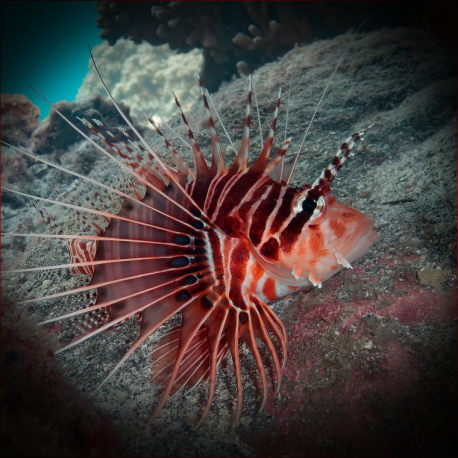More info
Datasheet
| Minimum Tank Size | 453 litres / 119.67 US gallons |
| Maximum Size | 7.6cm / 2.99inches |
| Reef Compatible | With Caution |
| Temperament | Semi-aggressive |
| Care Description | Moderate |
| Specific Gravity | 1.020-1.025 |
| Carbonate Hardness | 8-12 |
| pH | 8.1-8.4 |
General Description
The Antennata Lionfish, or Pterois antennata, commonly known as the Ragged-finned Firefish or Spotfin Lionfish, showcases red, white, and black vertical stripes across its body. Notably, this species boasts fan-like pectoral fins and tall, quill-like dorsal fins that lack connective tissue, lending them a spiny appearance.
Aquarium Suitability
With a minimum tank size recommended around 453 liters, the Antennata Lionfish is suitable for aquariums of 50 gallons or larger. Adequate hiding spots within the tank are crucial, as the lionfish tends to initially hide while adapting to its new habitat. Care must be taken with the venomous spines on its dorsal, pelvic, and anal fins, which can induce reactions akin to a bee sting but more potent.
Demands and Care
Categorized as a moderately demanding species, the Antennata Lionfish requires carnivorous sustenance. Feeding should start with live saltwater feeder shrimp to stimulate its appetite, eventually segueing into a diet primarily consisting of live shrimp (including ornamental varieties), live fish, and on occasion, crustacean flesh. The lionfish is semi-aggressive in temperament and necessitates stable water conditions with a pH range of 8.1-8.4, a specific gravity of 1.020-1.025, and a carbonate hardness (KH) of 8-12.
Reef Suitability
While the Antennata Lionfish is considered reef-compatible with caution, its predatory nature and venomous spines make it a potential threat to smaller fish and invertebrates in a reef setting. Careful consideration and monitoring are essential to ensure harmony within a reef aquarium.
Aquarium Setup
Creating an ideal habitat for the Antennata Lionfish involves providing ample hiding places amidst the rocky structure within the tank. Additionally, maintaining a secure lid is crucial to prevent the lionfish from jumping out of the aquarium. Monitoring water parameters regularly and ensuring a well-established nitrogen cycle are vital for the well-being of this species.
Behaviour
Known to exhibit semi-aggressive behavior, the Antennata Lionfish may display territorial tendencies, especially towards conspecifics or similar species. Care should be taken when introducing new tank mates to prevent aggression and territorial disputes.
Feeding and Diet
The diet of the Antennata Lionfish primarily consists of carnivorous selections, including live shrimp, fish, and crustaceans. Feeding typically starts with live saltwater feeder shrimp to entice the lionfish to eat, gradually transitioning to a varied diet to ensure balanced nutrition and overall health.
Dimorphism and Captive Reproduction
In terms of dimorphism and captive reproduction, the information available about the Antennata Lionfish is not detailed enough to provide specific insights into these aspects.
Habitat and Distribution
The natural habitat of the Antennata Lionfish encompasses the tropical waters of the Indo-Pacific region, where it can be found in reefs and rocky crevices at moderate depths. Its distribution ranges from the Red Sea to East Africa, extending eastward to the Tuamotu Archipelago and the Line Islands.

